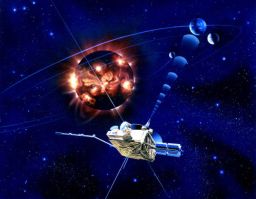Emily Lakdawalla • Mar 13, 2009
Ulysses: Still not dead yet
Not only is ESA's solar orbiter Ulysses still alive, but it actually has had a brief resurgence of science activity over the past couple of months.
First, a review. More than a year ago, on January 15, 2008, during Ulysses' 18th year in space, it lost its ability to use its main radio transmitter as a result of the degradation of its radioisotope power supply. Shortly afterward, ESA announced that the spacecraft would soon die because the hydrazine in its fuel lines was expected to freeze. But crafty mission controllers found a creative way to prevent the freezing: bleeding tiny amounts (1.2 grams) of the remaining hydrazine every two hours in order to keep the fuel moving. But this solution was obviously not a long-term one (as it can only work so long as there is hydrazine left), so ESA had a ceremonial send-off and wrap-up of the mission in mid-June, announcing that the spacecraft would be shut down on July 1. Yet Ulysses continued to survive, even into its 19th year. It was briefly imperiled by an anomaly in a sun sensor in September, but normal operations were recovered quickly.
Since the loss of the main radio transmitter, Ulysses has only been able to transmit real-time data, at a rate of 256 or 512 bps (bits per second). So the science team can only get data from the spacecraft during those periods when Ulysses is allotted time on a deep-space antenna. Still, they have gotten more than a year's worth of this realtime data since the anomaly, which is great.
The distance between Earth and Ulysses is increasing again, and the opportunity for 1024 bps communications is expected to close soon -- Nigel Angold says mid-March, so that's any day now. His latest status update also says that their models indicate that Ulysses has "almost no fuel left." Modeling is never perfectly precise, though; the needle on its tank may read "Empty" but there's evidently still a few drops left, because the fuel bleeding is still working and Ulysses is still alive as of today, monitoring the increase in the Sun's activity from its recent minimum.
Support our core enterprises
Your support powers our mission to explore worlds, find life, and defend Earth. You make all the difference when you make a gift. Give today!
Donate

 Explore Worlds
Explore Worlds Find Life
Find Life Defend Earth
Defend Earth


